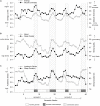Monitoring Training Loads and Perceived Stress in Young Elite University Athletes
- PMID: 30761016
- PMCID: PMC6361803
- DOI: 10.3389/fphys.2019.00034
Monitoring Training Loads and Perceived Stress in Young Elite University Athletes
Abstract
With increased professionalism in sport there has been a greater interest in the scientific approach to training and recovery of athletes. Applying appropriate training loads along with adequate recovery, is essential in gaining maximal adaptation in athletes, while minimizing harm such as overreaching, overtraining, injury and illness. Although appropriate physical stress is essential, stress for many athletes may come from areas other than training. Stress from may arise from social or environmental pressure, and for many athletes who combine elite athletic training with university study, academic workloads create significant stress which adds to the constant pressure to perform athletically. This research aimed to determine if subjective stressors were associated with counterproductive training adaptations in university athletes. Moreover, it aimed to elucidate if, and when, such stressors are most harmful (i.e., certain times of the academic year or sports training season). We monitored subjective (mood state, energy levels, academic stress, sleep quality/quantity, muscle soreness, training load) and objective (injury and illness) markers in 182 young (18-22 years) elite athletes over a 4-year period using a commercially available software package. Athletes combined full-time university study with elite sport and training obligations. Results suggest athletes were relatively un-stressed with high levels of energy at the beginning of each university semester, however, energy levels deteriorated along with sleep parameters toward the examination periods of the year. A logistical regression indicated decreased levels of perceived mood (0.89, 0.85-0.94, Odds Ratio and 95% confidence limits), sleep duration (0.94, 0.91-0.97) and increased academic stress (0.91, 0.88-0.94) and energy levels (1.07, 1.01-1.14) were able to predict injury in these athletes. Examination periods coincided with the highest stress levels and increased likelihood of illness. Additionally, a sudden and high increase in training workload during the preseason was associated with an elevated incidence of injury and illness (r = 0.63). In conclusion, young elite athletes undertaking full-time university study alongside their training and competition loads were vulnerable to increased levels of stress at certain periods of the year (pre-season and examination time). Monitoring and understanding these stressors may assist coaches and support staff in managing overall stress in these athletes.
Keywords: academic stress; athlete monitoring; athletic performance; illness; injury; sport training; student-athletes.
Figures




References
-
- Andersen M. B., Williams J. M. (1988). A model of stress and athletic injury: prediction and prevention. J. Sport Exerc. Psychol. 10 294–306. - PubMed
-
- Cohen J. (1988). Statistical Power for the Behavioural Sciences. Hillsdale, NJ: Lawrence Erlbaum.
LinkOut - more resources
Full Text Sources
Other Literature Sources

